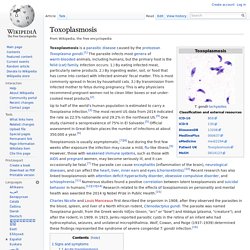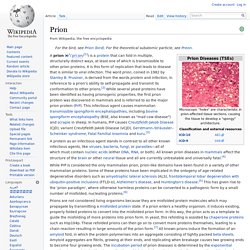

How Your Cat Is Making You Crazy - Kathleen McAuliffe. No one would accuse Jaroslav Flegr of being a conformist.

A self-described “sloppy dresser,” the 53-year-old Czech scientist has the contemplative air of someone habitually lost in thought, and his still-youthful, square-jawed face is framed by frizzy red hair that encircles his head like a ring of fire. Certainly Flegr’s thinking is jarringly unconventional. Starting in the early 1990s, he began to suspect that a single-celled parasite in the protozoan family was subtly manipulating his personality, causing him to behave in strange, often self-destructive ways.
And if it was messing with his mind, he reasoned, it was probably doing the same to others. The parasite, which is excreted by cats in their feces, is called Toxoplasma gondii (T. gondii or Toxo for short) and is the microbe that causes toxoplasmosis—the reason pregnant women are told to avoid cats’ litter boxes. But after years of being ignored or discounted, Flegr is starting to gain respectability. The psychiatrist E. Toxoplasmosis. Toxoplasmosis is a parasitic disease caused by the protozoan Toxoplasma gondii.[1] The parasite infects most genera of warm-blooded animals, including humans, but the primary host is the felid (cat) family.

Infection occurs: 1.) By eating infected meat, particularly swine products. 2.) By ingesting water, soil, or food that has come into contact with infected animals' fecal matter. This is most commonly spread in feces by household cats. 3.) By transmission from infected mother to fetus during pregnancy. Up to half of the world's human population is estimated to carry a Toxoplasma infection.[3] The most recent US data from 2014 indicated the rate as 22.5% nationwide and 29.2% in the northeast US.[4] One study claimed a seroprevalence of 75% in El Salvador.[5] Official assessment in Great Britain places the number of infections at about 350,000 a year.[6] Signs and symptoms[edit] Infection has three stages: List of parasites of humans. Transmissible spongiform encephalopathy. Classification[edit] History[edit] In the 5th century BCE, Hippocrates described a disease like TSE in cattle and sheep, which he believed also occurred in man.[4] Publius Flavius Vegetius Renatus records cases of a disease with similar characteristics in the 4th and 5th centuries AD.[5] In 1755, an outbreak of scrapie was discussed in the British House of Commons and may have been present in Britain for some time before that.[6] Although there were unsupported claims in 1759 that the disease was contagious, in general it was thought to be due to inbreeding and countermeasures appeared to be successful.

Early-20th-century experiments failed to show transmission of scrapie between animals, until extraordinary measures were taken such as the intra-ocular injection of infected nervous tissue. No direct link between scrapie and disease in man was suspected then or has been found since. Trichomoniasis. Trichomoniasis, sometimes referred to as "trich", is a common cause of vaginitis.

It is a sexually transmitted disease, and is caused by the single-celled protozoan parasite Trichomonas vaginalis producing mechanical stress on host cells and then ingesting cell fragments after cell death.[1] Trichomoniasis is primarily an infection of the urogenital tract; the most common site of infection is the urethra and the vagina in women. Signs and symptoms[edit] Symptoms experienced include pain, burning or itching in the penis, urethra (urethritis), or vagina (vaginitis). Discomfort for both sexes may increase during intercourse and urination. For women there may also be a yellow-green, itchy, frothy, foul-smelling ("fishy" smell) vaginal discharge.
Diagnosis[edit] Causes[edit] Lifecycle of Trichomonas The human genital tract is the only reservoir for this species. Prion. A prion ( A protein as an infectious agent stands in contrast to all other known infectious agents, like viruses, bacteria, fungi, or parasites—all of which must contain nucleic acids (either DNA, RNA, or both).

All known prion diseases in mammals affect the structure of the brain or other neural tissue and all are currently untreatable and universally fatal.[4] While PrP is considered the only mammalian prion, prion-like domains have been found in a variety of other mammalian proteins. Some of these proteins have been implicated in the ontogeny of age-related degenerative disorders such as amyotrophic lateral sclerosis (ALS), frontotemporal lobar degeneration with ubiquitin-positive inclusions (FTLD-U), Alzheimer's disease, and Huntington's disease.[5] This has given rise to the 'prion paradigm', where otherwise harmless proteins can be converted to a pathogenic form by a small number of misfolded, nucleating proteins.[6]